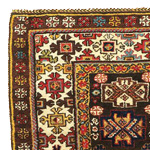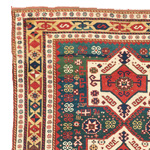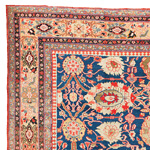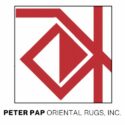Types of Rugs

Nomadic Rugs
Nomadic carpets were woven from memory and were originally made for personal use rather than for sale. They had both a practical use (e.g., grain bags or ground coverings) and ceremonial use (e.g., horse trappings). These carpets were woven with traditional and sacred patterns handed down through generations, tracing the culture of the makers through the designs and techniques employed. Nomadic rugs tend to feature simpler, more powerful designs, open fields, and primary colors. Asymmetry and idiosyncratic design elements make up a lot of the charm we find in these rugs. The use of more primitive looms and thicker strands of wool results in a coarser weave, which also leads to more geometric designs. Nomadic rugs often contain some inaccuracies or mistakes, but these tend to give character to the rug and connect us to the individual who created it.
Examples of Nomadic rug types include Bakhtiari, Qashqai, Kurdish, Afshar, Tekke, Ersari, Yomut, Chodor, and Shahsevan.

Village Rugs
Village rugs were largely woven by women working at home in their spare time to create rugs for sale. They tend to be marked by bright colors and a high degree of creativity, combining tribal influences with greater sophistication in trying to satisfy the market. Often village rug makers would take a traditional or popular design and rework it in a creative and unique way, leading to significant variability and a large number of unique carpets. These rugs were either woven from memory or with the aid of a drawing. Some of their appeal comes from their inexact nature relative to workshop rugs. They tend to feature more repeating patterns and are less conservative as village weavers were always on the lookout for new ideas. Village rugs are highlighted by strong colors and bold angularity, which retains a homemade individuality and a more primitive, coarser element relative to workshop rugs.
Examples of Village rug types include Kazak, Karabagh, Shirvan, Kuba, Bergama, Ladik, Mudjur, Melas, Bidjar, and Karadja.

Workshop Rugs
Workshop rugs mark the advent of standardized production of rugs for commerce. These rugs were woven in an organized setting, with weavers being paid a wage to render predetermined designs. Weavers worked from a visual guide, or “cartoon” following knot for knot in a specialized pattern. These guides, combined with larger and more sophisticated looms, allowed for a finer weave and more complex designs. Workshop rugs are typified by minute ornamentation often covering the entire field, a sophisticated color palette, intricate patterns, classical themes, and faultless workmanship.
Examples of Workshop rug types include Tabriz, Sarouk, Oushak, Kirman, Kashan, and Heriz.
